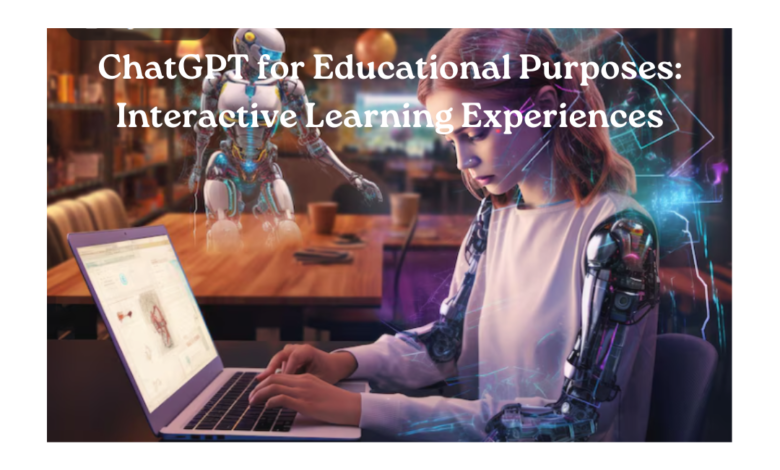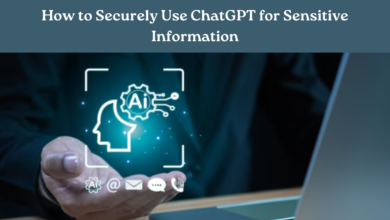ChatGPT for Educational Purposes: Interactive Learning Experiences

Introduction to ChatGPT
ChatGPT, from OpenAI, is a leading-edge language model driving progress in natural language processing (NLP). Built on the Transformer architecture and trained with extensive text data, ChatGPT excels at generating human-like text responses. It operates as an advanced conversational agent, employing deep learning to analyze input prompts and produce contextually relevant and coherent text, mimicking human conversation with impressive accuracy.
Functionality of ChatGPT
ChatGPT excels in generating human-like text responses to user input. Users interact with it by entering text queries or prompts and receiving coherent and contextually relevant answers. Unlike rule-based chatbots, ChatGPT dynamically generates responses based on its extensive understanding of language patterns and semantics.
Key Features of ChatGPT
1. Contextual Understanding:
ChatGPT can maintain context over multiple turns of conversation, understanding nuances and maintaining coherence throughout the interaction.
2. Natural Response Generation:
This model is adept at generating text that closely resembles natural human language, tailoring its responses to the input it receives.
3. Scalability and Versatility:
ChatGPT’s architecture allows it to handle a wide range of topics and conversation types, making it adaptable for various applications, including educational purposes.
4. Human-Like Text Generation:
ChatGPT’s human-like text generation, leveraging extensive training data, allows for interactive educational experiences where students engage in simulated dialogue to enhance comprehension and interaction with educational content.
Applications of ChatGPT in Education
In recent years, ChatGPT has emerged as a transformative tool in the field of education, offering a range of applications that enhance personalized learning experiences and facilitate interactive engagement for students across various subjects and disciplines.
1. Personalized Tutoring
ChatGPT simulates personalized tutoring by providing tailored explanations and adapting responses to each student’s level and pace. This AI model offers instant feedback and clarification, helping students understand complex concepts effectively alongside traditional classroom instruction.
2. Interactive Q&A Sessions
Students engage in dynamic Q&A sessions with ChatGPT to deepen their understanding of topics. This virtual assistant responds to a variety of inquiries, fostering a continuous dialogue that promotes active learning and critical thinking, encouraging students to explore diverse perspectives.
3. Language Learning
ChatGPT supports language learning through immersive writing and conversation practice. By engaging in interactive dialogues, students refine language skills, receive real-time corrections, and explore cultural nuances, enhancing proficiency and linguistic experimentation.
4. Concept Exploration
ChatGPT facilitates concept exploration by engaging students in interactive dialogues on complex subjects. By posing questions and receiving detailed explanations, students navigate intricate topics at their own pace, reinforcing comprehension and retention and encouraging curiosity-driven learning.
Data Science Education and ChatGPT
1. Exploring Data Science Concepts
ChatGPT can explain data science concepts, algorithms, and statistical methods. It can break down complex topics into digestible explanations, making them accessible to students.
2. Code Debugging and Problem Solving
Students can present code snippets to ChatGPT for assistance with debugging. It can identify errors, suggest improvements, and guide students through problem-solving steps.
Benefits of Using ChatGPT for Learning
ChatGPT, an advanced AI language model, offers a range of benefits that enhance learning experiences for students in diverse educational settings. From accessibility to engagement and adaptability, ChatGPT’s unique features contribute to personalized and interactive learning environments.
1. Accessibility:
ChatGPT is accessible anytime, anywhere, with an internet connection, eliminating barriers of time and location associated with traditional tutoring. Students can engage with ChatGPT from home, school, or on the go, ensuring continuous access to educational assistance.
2. Engagement:
ChatGPT’s engaging interface fosters active participation and dialogue, encouraging curiosity-driven exploration. By simulating human-like interactions, ChatGPT enhances learning motivation and interest, complementing traditional instructional methods.
3. Adaptability:
ChatGPT adapts to individual learning styles and pacing by learning from student interactions. It tailors explanations and content delivery based on unique preferences, maximizing comprehension and retention across diverse learning styles.
4. Additional Benefits
- Instant Feedback: ChatGPT provides immediate feedback and explanations, facilitating real-time learning and comprehension.
- Comprehensive Resource: ChatGPT offers comprehensive educational support with explanations, examples, and insights across various subjects.
- Promotion of Critical Thinking: Engaging in dynamic dialogues with ChatGPT helps students develop critical thinking and analytical skills.
Challenges and Considerations
Implementing ChatGPT in education presents challenges that require careful attention to ensure ethical, effective, and unbiased use.
1. Understanding Context
ChatGPT may struggle with nuanced contexts in conversations, leading to inaccuracies. Educators can mitigate this by:
- Providing clear and specific prompts.
- Encouraging students to offer additional context or rephrase questions.
- Implementing post-response checks for accuracy.
2. Biases in Responses
ChatGPT’s training data may contain biases, resulting in biased responses. Educators can address this by:
- Regularly evaluating ChatGPT’s responses for biases.
- Incorporating diverse perspectives and inclusive language in training data.
- Implementing bias detection and correction techniques.
3. Ethical Considerations
The use of AI technologies often gives rise to ethical concerns, particularly regarding issues related to privacy and data security. Educators should:
- Obtain informed consent from students and parents/guardians.
- Implement robust data protection measures.
- Provide transparency on AI usage and data handling.
4. Mitigation Strategies
To mitigate challenges, educators can:
- Continuously monitor and evaluate ChatGPT’s performance.
- Maintain human oversight during interactions.
- Educate students on AI capabilities and limitations.
- Foster collaboration among educators, researchers, and developers to enhance AI-driven educational tools.
Ethical and Privacy Considerations
The integration of AI technologies such as ChatGPT in educational settings presents unique ethical challenges and privacy concerns that educators and stakeholders must carefully address to uphold ethical standards and safeguard student privacy.
1. Ethical Considerations
The use of AI in education raises important ethical considerations that require thoughtful consideration and proactive measures:
i) Transparency:
Educators must ensure transparency regarding the use of AI technologies like ChatGPT, including how student data is collected, processed, and utilized.
ii) Fairness and Bias:
AI models can inadvertently perpetuate biases present in training data, potentially leading to unfair or discriminatory outcomes. To guarantee fair educational experiences, it is essential to consistently observe and address biases.
iii) Accountability:
Educators and developers must establish accountability mechanisms to address issues such as algorithmic accountability and the responsible use of AI technologies in educational contexts.
iv) Student Autonomy:
Respect for student autonomy involves providing students with informed choices regarding their interactions with AI-powered tools and ensuring that AI complements, rather than replaces, human-driven educational experiences.
2. Privacy Concerns
Privacy is a paramount consideration when implementing AI-powered tools like ChatGPT in educational environments:
i) Data Collection and Storage:
AI models like ChatGPT require access to student data to provide personalized interactions. Educators must ensure that student data is collected and stored securely, following established privacy guidelines and regulations.
ii) Data Access and Sharing:
Educators should restrict access to student data to authorized personnel only and avoid unnecessary data sharing with third parties.
iii) Informed Consent:
Obtain informed consent from students and parents/guardians regarding the use of AI technologies in education, clearly outlining the purposes, risks, and implications of data collection and usage.
iv) Data Anonymization and Minimization:
Implement strategies such as data anonymization and minimization to protect student privacy while still enabling effective AI-driven educational experiences.
Mitigating Ethical and Privacy Concerns
To mitigate ethical and privacy concerns associated with using AI technologies like ChatGPT in education, educators can implement the following strategies:
- Conduct regular ethical reviews and assessments of AI implementations to identify and address potential ethical issues.
- Implement robust data protection measures, including encryption, access controls, and secure data storage practices.
- Provide comprehensive training to educators and students on best practices for privacy and responsible AI usage.
- Foster transparency and accountability through clear communication and governance frameworks governing AI usage in educational settings.
Conclusion:
Implementing ChatGPT in education presents significant challenges, including contextual understanding, biases in responses, and ethical considerations like privacy and data security. Educators can address these challenges by improving contextual prompts, evaluating responses for biases, implementing data protection measures, and fostering collaboration to enhance the ethical and effective use of AI-driven educational tools.
Please visit www.intogeeks.com to know more uses of ChatGPT.




